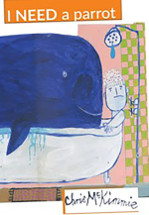I need a parrot by Chris McKimmie

Ford St, 2019. ISBN: 9781925804287.
(Age: 4+) Highly recommended. Themes: Wants and needs, Humour.
McKinnie's quirky play with words and illustrations will appeal
widely as the boy in the story says simply, I NEED a parrot. Ideas
will stream into the readers' minds as they too ask the question,
what do I need? A parrot is probably the last thing many would admit
to needing, so the question arises, why a parrot? With that question
in mind, the ideas will come thick and fast as the illustrations
show the boy rejecting a parrot hand puppet and a turkey,
questioning a whale in his bath (blue of course) and a shark in his
pool, telling the reader that he already has a bear (although not a
real bear) and a cat. He promises that he will clean its cage, teach
it words, feed it and love it.
Up to this point, the boy is adamant that a parrot is what he needs
and the reader will go along with story but seeing the parrot in a
cage will stop them in their tracks and make them take a breath. The
story changes from a boy's wanting a parrot to the awfulness of a
large bird kept in a cage, where once he had a sky full of blue in
which to fly. And that point is underlined with a page filled with
blue, a huge sky for the bird to fly freely. The boy now says 'Oh',
realising the consequences of his demand. But over the page,
McKinnie brings another bolt of humour, one all readers will
recognise.
McKimmie's humour packs a wallop: lulled into the voice of the hero,
going along with his well rehearsed reasons and promises to persuade
his parents about the inclusion of a parrot in the household, the
aim of the story changes to more of an environmental one, where the
parrot's needs, not the boy's, are paramount.
It makes for a thrilling read, laughing along with the recognisable
wheedlings of a child in wanting something, then pushed into the
thought for something other than themselves, children will question
the need of a parrot in their lives. The idea of a parrot, or any
pet bird in particular, is brought into question with the series of
cages shown throughout the story.
McKimmie's illustrative style is most distinctive, and readers will
recognise the images he uses, a multiplicity of techniques including
collage, paint, pencils and gouache, with ease, recalling other books
they have read.
The images build a domestic background against which the boy pleads
his case, his face looking directly at the reader, forming a bond.
Laugh out loud illustrations will evoke comment as the theme changes
in the book, pushing the readers to give more thought to their
requests.
Fran Knight